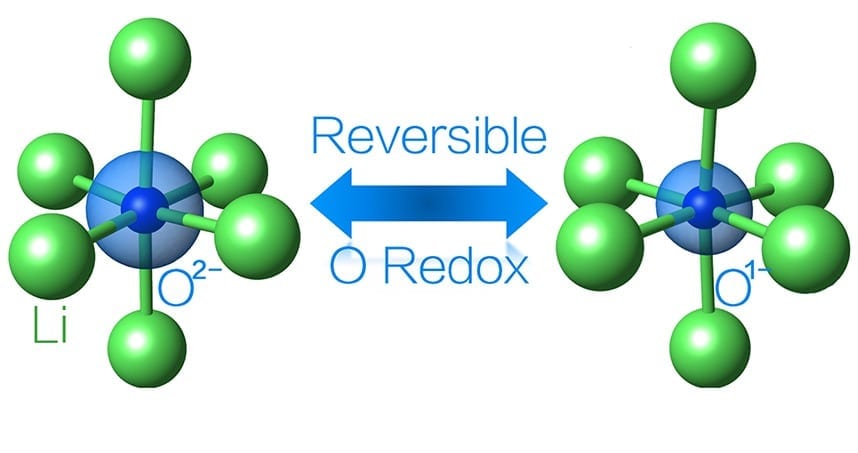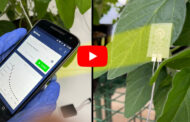
Iowa State University researchers have developed these “plant tattoo sensors” to take real-time, direct measurements of water use in crops.
Photo courtesy of Liang Dong.
Iowa State University plant scientist Patrick Schnable quickly described how he measured the time it takes for two kinds of corn plants to move water from their roots, to their lower leaves and then to their upper leaves.
This was no technical, precise, poster talk. This was a researcher interested in working with new, low-cost, easily produced, graphene-based, sensors-on-tape that can be attached to plants and can provide new kinds of data to researchers and farmers.
“With a tool like this, we can begin to breed plants that are more efficient in using water,” he said. “That’s exciting. We couldn’t do this before. But, once we can measure something, we can begin to understand it.”
The tool making these water measurements possible is a tiny graphene sensor that can be taped to plants – researchers have dubbed it a “plant tattoo sensor.” Graphene is a wonder material. It’s a carbon honeycomb just an atom thick, it’s great at conducting electricity and heat, and it’s strong and stable. The graphene-on-tape technology in this study has also been used to produce wearable strain and pressure sensors, including sensors built into a “smart glove” that measures hand movements.
Researchers describe the various sensors and the “simple and versatile method for patterning and transferring graphene-based nanomaterials” to create the flexible sensors in a paper featured on the cover of the December 2017 issue of the journal Advanced Materials Technologies.
The research has been primarily supported by the Faculty Scholars Program of Iowa State’s Plant Sciences Institute.
Liang Dong, an Iowa State associate professor of electrical and computer engineering, is the lead author of the paper and developer of the technology. Seval Oren, a doctoral student in electrical and computer engineering, is a co-author who helped develop the sensor-fabrication technology. Co-authors who helped test applications of the sensors are Schnable, director of Iowa State’s Plant Sciences Institute, a Charles F. Curtiss Distinguished Professor in Agriculture and Life Sciences, the Iowa Corn Promotion Board Endowed Chair in Genetics and the Baker Scholar of Agricultural Entrepreneurship; and Halil Ceylan, a professor of civil, construction and environmental engineering.
“We’re trying to make sensors that are cheaper and still high performing,” Dong said.
To do that, the researchers have developed a process for fabricating intricate graphene patterns on tape. Dong said the first step is creating indented patterns on the surface of a polymer block, either with a molding process or with 3-D printing. Engineers apply a liquid graphene solution to the block, filling the indented patterns. They use tape to remove the excess graphene. Then they take another strip of tape to pull away the graphene patterns, creating a sensor on the tape.
The process can produce precise patterns as small as 5 millionths of a meter wide – just a twentieth of the diameter of the average human hair. Dong said making the patterns so small increases the sensitivity of the sensors.
(The process, for example, produced a detailed image of Iowa State’s Cyclone mascot that was less than 2 millimeters across. “I think this is probably the smallest Cyclone,” Dong said.)
“This fabrication process is very simple,” Dong said. “You just use tape to manufacture these sensors. The cost is just cents.”
In the case of plant studies, the sensors are made with graphene oxide, a material very sensitive to water vapor. The presence of water vapor changes the conductivity of the material, and that can be quantified to accurately measure transpiration (the release of water vapor) from a leaf.
The plant sensors have been successfully tested in lab and pilot field experiments, Dong said.
A new three-year, $472,363 grant from the U.S. Department of Agriculture’s Agriculture and Food Research Initiative will support more field testing of water transport in corn plants. Michael Castellano, an Iowa State associate professor of agronomy and William T. Frankenberger Professor in Soil Science, will lead the project. Co-investigators include Dong and Schnable.
The Iowa State University Research Foundation has applied for a patent on the sensor technology. The research foundation has also granted an option to commercialize the technology to EnGeniousAg – an Ames startup company co-founded by Dong, Schnable, Castellano and James Schnable, an assistant professor of agronomy and horticulture at the University of Nebraska-Lincoln, a collaborator on another Iowa State sensor project that sparked establishment of the company (and Patrick Schnable’s son).
“The most exciting application of the tape-based sensors we’ve tested so far is the plant sensor,” Dong said. “The concept of wearable electronic sensors for plants is brand new. And the plant sensors are so tiny they can detect transpiration from plants, but they won’t affect plant growth or crop production.”
But that’s not all the sensors can do. The technology could “open a new route” for a wide variety of applications, the authors wrote in their paper, including sensors for biomedical diagnostics, for checking the structural integrity of buildings, for monitoring the environment and, after appropriate modifications, for testing crops for diseases or pesticides.
The Latest on: Plant tattoo sensor
[google_news title=”” keyword=”plant tattoo sensor” num_posts=”10″ blurb_length=”0″ show_thumb=”left”]
- 17 May Birth Flower Tattoos to Celebrate Your Birthdayon April 26, 2024 at 10:45 pm
These May birth flower tattoos will help you celebrate your birthday in style. See examples of unique, minimalist, and colorful tattoo designs.
- AI deciphers new gene regulatory code in plants and makes accurate predictions for newly sequenced genomeson April 26, 2024 at 9:05 am
Genome sequencing technology provides thousands of new plant genomes annually. In agriculture, researchers merge this genomic information with observational data (measuring various plant traits) to ...
- 20 Beautiful April Birth Flower Tattooson April 23, 2024 at 10:25 pm
These April birth flower tattoos will help you celebrate the month you were born. See examples of unique, minimalist, and colorful tattoo designs.
- MIT Technology Reviewon April 23, 2024 at 2:00 pm
Electrical engineer Nili Persits, PhD ’24, has developed low-cost Raman spectroscopy systems that allow instant chemical analysis.
- Researchers pioneer sensor multiplexing for real-time decoding of different plant stresseson April 23, 2024 at 6:25 am
Science X is a network of high quality websites with most complete and comprehensive daily coverage of the full sweep of science, technology, and medicine news ...
- Researchers pioneer nanosensor multiplexing for real-time decoding of different plant stresseson April 22, 2024 at 4:59 pm
SA is a crucial plant hormone for growth, development, and stress response to pathogens, temperature, drought, salinity, metals, UV light, and osmotic stress. The researchers also pioneered a method ...
- Plant sensors could act as an early warning system for farmerson April 17, 2024 at 6:20 am
Using a pair of sensors made from carbon nanotubes, researchers from MIT and the Singapore-MIT Alliance for Research and Technology (SMART) have discovered signals that reveal when plans are ...
- 45 Flower Forearm Tattoo Ideas to Consider Before Your Next Ink Sessionon April 16, 2024 at 4:30 am
If you're looking for flower forearm tattoo ideas, we've got you covered with tons of inspo. We've rounded up 45 examples of flower forearm tattoos inside.
- From Lavender To Ferns, Pressed Flower Tattoos Are Trending In 2024on March 9, 2024 at 6:11 am
When it comes to small, unique tattoos, the micro heart or sticker sleeve has clearly been done. This year, one trend is on the rise—the pressed flower tattoo. Yes, it’s an actual tattoo ...
- Tattoos Inspired By Vintage Botanical Gucci Scarveson September 22, 2022 at 7:28 am
Flowers are practically a proverb when it comes to beauty, art design, and yes, even tattoos. Just look at the classic Gucci scarf, emblazoned with a pattern of stylish plants and petals ...
via Google News and Bing News







